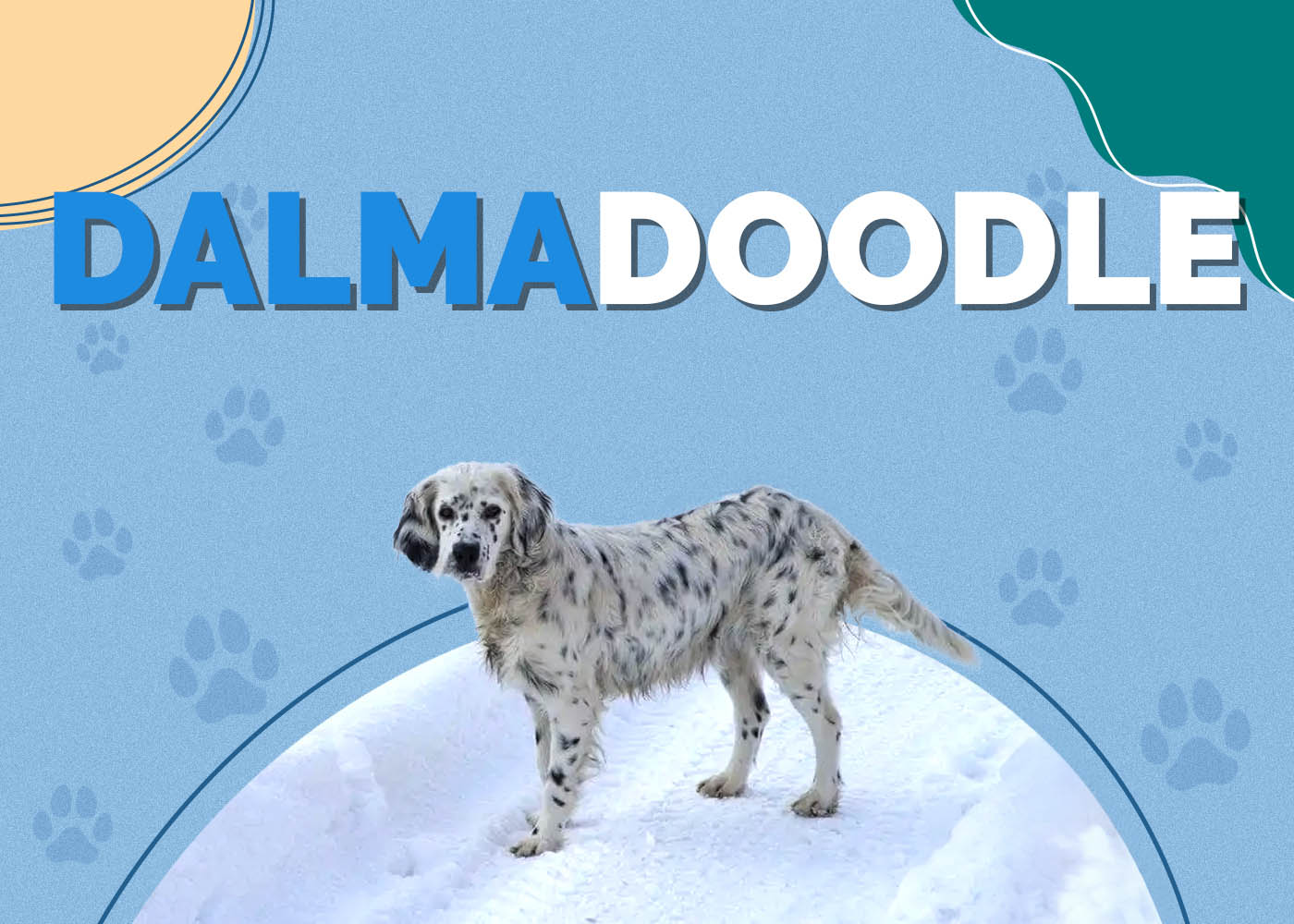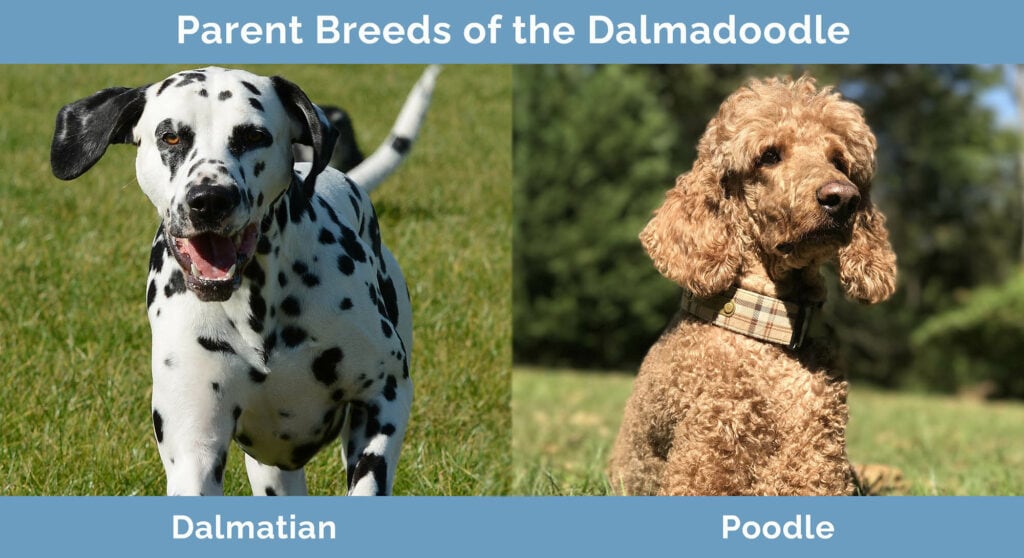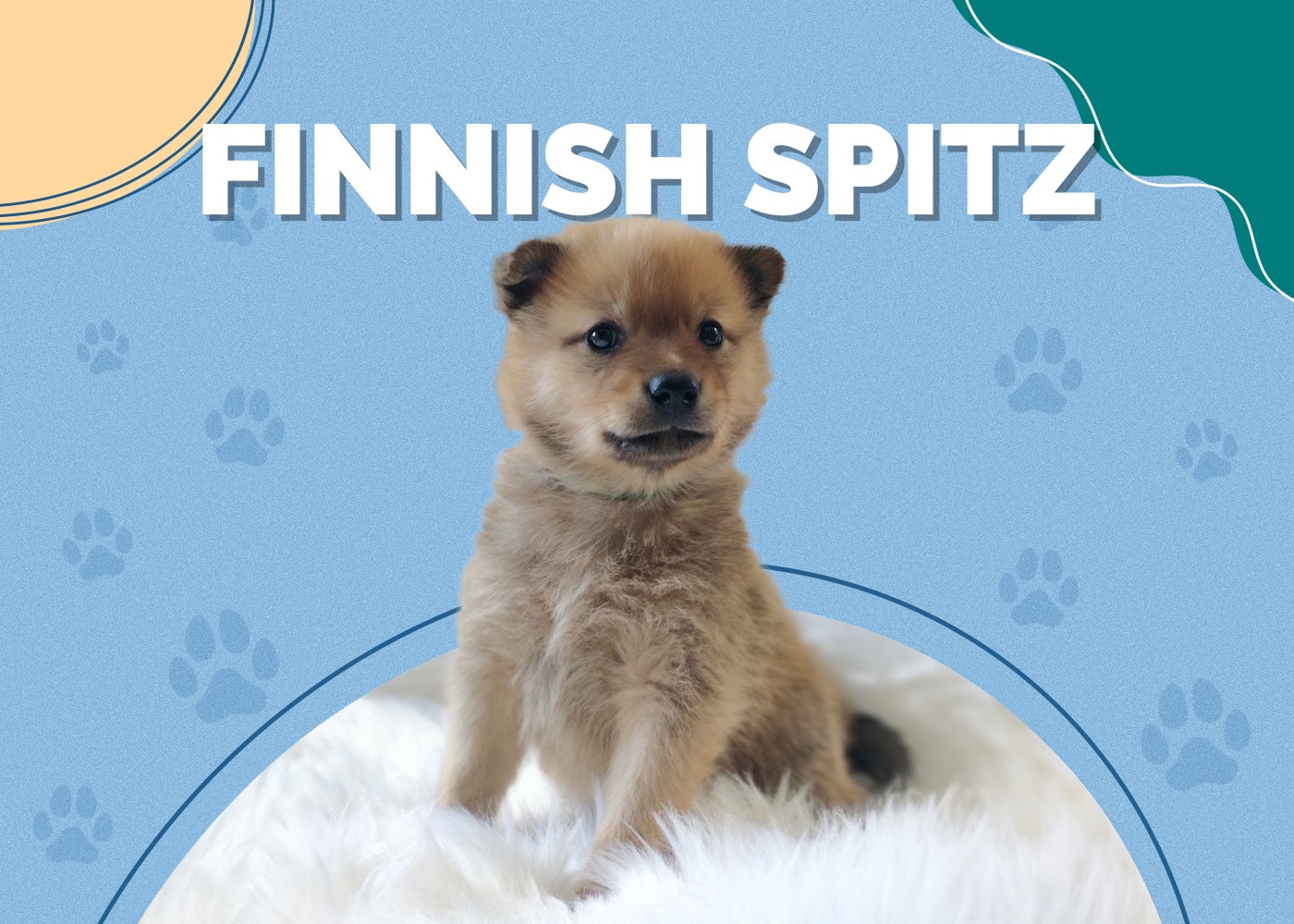Dalmadoodle (Dalmatian & Poodle Mix): Info, Pictures, Characteristics & Facts

Updated on

Height:
20 – 24 inches
Weight:
40 – 70 pounds
Lifespan:
11 – 14 years
Colors:
White, black
Suitable for:
Active families, anyone who wants a low-maintenance dog
Temperament:
Friendly, stubborn, energetic, intelligent, loyal
You’d likely struggle to name two dog breeds that are more instantly recognizable than the Poodle and Dalmatian, so it’s no surprise that some enterprising dog breeder decided to see what would happen if they mixed the two.
The result is a dog who’s just as distinctive as their parents yet extremely affectionate and intelligent. These pups make great companion animals who love to stick by your side at all times, and they’re incredibly smart, so they can help you when you’re shouting out answers to “Jeopardy!”
They’re not without their shortcomings, however. For one thing, they’re prone to a variety of health problems and are quite stubborn. If you can afford to spend the time necessary to train them and the money to repair them, though, you’ll have a truly fantastic pet on your hands.
Dalmadoodle Puppies
Many designer breeds look like a perfect mix of their parents. That’s not usually the case with Dalmadoodles. These dogs tend to look like Poodles or like Dalmatians, with little in-between. The only consistent aspect is their black-and-white spotting, but beyond that, no one knows what you’ll get from one of these dogs.
So, if you have your heart set on the grown-up Dalmatian Poodle mix looking a certain way, this breed may not be for you. However, if the breed’s other charms make you willing to overlook an unpredictable appearance, read on for a primer on what to expect from these pooches.
3 Little-Known Facts About the Dalmadoodle
1. These Dogs Don’t Handle the Heat Well
While Dalmadoodles can put up with cold weather without any issue, they struggle in the heat. Be sure to keep a close eye on your dog when playing during the summer, and be sure to stop if they start to pant too heavily.
The good news is that these dogs typically love the water, so you can always hose them down or let them in the pool if you’re worried they’re starting to get too hot under the collar.
2. Dalmadoodles Love Having a Job
Both parent breeds were designed to be working animals. Dalmatians were bred to trot next to horse-drawn carriages, and of course, they’re famously the mascot of many fire departments. Poodles, on the other hand, were created to fetch fallen waterfowl.
When you combine the two breeds, you get a dog who loves to be put to work. It doesn’t matter the job; if you can make your Dalmadoodle feel like they’re earning their keep, you’ll have one happy dog indeed.
3. They’re Not Ideal for Apartment Dwellers
As you might expect from a dog who works all day for a living, Dalmadoodles have incredible endurance. They can run and play for hours on end and not be any worse for the wear.
That means you’ll likely need a big backyard if you want to adopt s Dalmatian Poodle mix, because they might get destructive in a cramped apartment. At the very least, you should live near a big, open park — preferably an off-leash dog park.

Temperament & Intelligence of the Dalmadoodle 🧠
Poodles and Dalmatians are both among the smartest dog breeds on the planet, so it’s to be expected that a mix of the two should be fiercely intelligent.
These dogs can quickly pick up on anything you want them to — and a few things you don’t. They can be inspired escape artists, and good luck hiding treats from them.
They also often inherit the Dalmatian’s stubborn streak, which when combined with their ridiculous IQs, can make for a challenging training experience. You’ll need to stay on top of their training. However, even at their worst, the Dalmatian Poodle mix isn’t usually that bad. They’re affectionate and loving, so you should rarely have to worry about aggression issues (resource guarding can occasionally be a problem, however).
If you don’t challenge them physically and mentally every day, though, you might come home to find your shoes in tiny pieces or multiple holes dug in your lawn.
Are These Dogs Good for Families? 🏡
These dogs make excellent family pets and they’re especially good with children.
They can be protective of their human siblings, so be careful about introducing them to new people when they’re around your kids. They tend to be a bit standoffish around newcomers, but it quickly wears off, provided they pass the dog’s test, of course.
The bigger your family, the more likely you’ll be able to keep up with these tireless animals. It may help to divvy up the exercise between multiple family members so no one gets burned out.
Does This Breed Get Along With Other Pets? 🐶 😽
Dalmadoodles usually get along famously with other dogs. After all, another dog is about the only thing that can keep up with them.
Poodles have a hunting background, though, so many Dalmadoodles have a strong prey drive. This could be a problem if your household includes cats or other small pets.
It’s hard to know in advance if your dog will get along with the cat, but there are a few things you can do to make a happy cohabitation more likely. Keeping your dog tuckered out is important, and proper training and socialization are non-negotiable (they should be especially good with the “leave it” command).
Things to Know When Owning a Dalmadoodle
While Dalmadoodles make fantastic pets, they can be quite demanding of their owner’s time and affection. Before you add one to your menagerie, you should do your homework to make sure they’ll fit in. Below, we’ll guide you through a few things you can expect when owning one of these dogs.
Food & Diet Requirements 🦴
Given that they can run for days, Dalmadoodles need plenty of kibble to keep their engines running. Expect to buy a bag of food a month. That food should be high-quality too. Skip anything with wheat, corn, or animal by-products, and focus on something that provides protein and healthy fruits and vegetables. Omega fatty acids are also important, as they help with brain development, and these dogs’ noodles need all the fuel they can get.
Be careful not to overfeed them, as hip dysplasia is common in the breed. However, they often tend to be more enthusiastic about praise and playtime than food, so they might not eat to the point of obesity, anyway.
Exercise 🐕
It’s virtually impossible to exercise a Dalmadoodle too much, as they thrive on being challenged both mentally and physically. Expect to give them at least an hour of vigorous activity every day, but preferably more. Do be careful during the summer months, though.
While they enjoy just about any physical activity, they do best when their minds are as stimulated as their bodies. They love having a job to do, so if you can find a task for them, they’ll be in heaven.
Long walks, puzzle toys, and agility training are all good ideas with the Dalmatian Poodle mix, and if your pup enjoys swimming, you’ll find that it’s a fantastic, low-impact way to burn off energy.
Training 🦮
Dalmadoodles love to learn, so long training sessions should be beneficial for both of you. They’ll pick up on just about anything you ask of them in no time at all, making it incredibly easy to teach them.
Socialization is important for these dogs, as they can be aloof and standoffish around strangers unless they’ve been properly acclimated to meeting new people. Introduce them to strangers, new situations, and other animals as safely and often as you can.
They do equally well in one-on-one training situations or group classes, so it’s up to you which you prefer. However, we recommend doing at least one or two group classes, as they allow you to both train and socialize your Dalmadoodle at the same time.
As far as training methodologies are concerned, these dogs do best with plenty of positive reinforcement. Any attempts to punish them will likely only render them skittish, and they may even start to rebel. And these mutts are smart enough that you definitely don’t want them thinking of ways to get even.
Grooming ✂️
Dalmatian Poodle mixes tend to look like one or the other of their parents rather than an even mix of the two. That means that their coats could be short and wiry like a Dalmatian’s, or they could have longer, softer hair like a Poodle.
This will determine how often you need to groom them. If their hair is long, you’ll need to brush them every other day or so, and you might want to have a standing appointment to get them a haircut every month. If they’re more like Dalmatians, then you can ease up on the grooming a little bit. Still, you’ll likely want to brush them at least once a week with a wire brush and maybe even a vacuum.
Dalmatian Poodle mixes need their teeth brushed and nails trimmed as often as any other dog, but they don’t have any special requirements in this regard. You do need to clean out their ears regularly to avoid infection, though.
- See Also: 11 Best Dry Dog Shampoos
Health and Conditions ❤️
Many designer breeds exist specifically to correct health issues in their parent breeds, and mixes are usually healthier than purebreds.
However, while Dalmadoodles are certainly healthier than Dalmatians, they still have quite a few health problems — more than the average designer breed, in fact.
Here are a few things to be concerned about as you raise your Dalmadoodle:
- Ear infections
- Skin allergies
- Eye issues
- Hip dysplasia
- Deafness
- Addison’s disease
- Bloat
- Cushing’s disease
- Urinary stones
- Epilepsy
Male vs. Female
There aren’t many differences between the male and the female Dalmadoodles in terms of physical stature. Males can get a bit bigger on the larger end of the spectrum, but on average, they’re basically the same size.
The male Dalmatian Poodle mix tends to be a bit more independent and stubborn, so a girl puppy will likely be easier to train; she’ll also probably be more of a clinger. The ladies are especially affectionate around children.
The male Dalmadoodles are more likely to become obsessive about something, like a new toy. This can lead to them ignoring you or simply not registering that you’re giving them a command. However, the female Dalmadoodles tend to do better when left alone and are less likely to develop separation anxiety.
Final Thoughts on the Dalmadoodle
If you want a dog who stands out in a crowd, the Dalmadoodle may be just what you’re looking for. These distinctive-looking dogs certainly make a statement, and while their appearance is often unpredictable, it’s always adorable.
Raising a Dalmadoodle can be a challenge, though. While they’re incredibly smart, they’ve been known to be stubborn, and they’re more prone to health issues than many other hybrid breeds.
If you’re willing to put in the time, effort, and money, then a Dalmadoodle can make a fantastic companion for you and your entire family. Just be prepared for the possibility that they can do a better job of helping your kids with their homework than you could.
See Also:
- Aussie Dalmatian Mix: Pictures, Care Guide, Temperament & Traits
- Pomeranian Dalmatian Mix: Pictures, Care Guide, Temperament & Traits
Featured Image Credit: E. Kotsinova, Shutterstock













